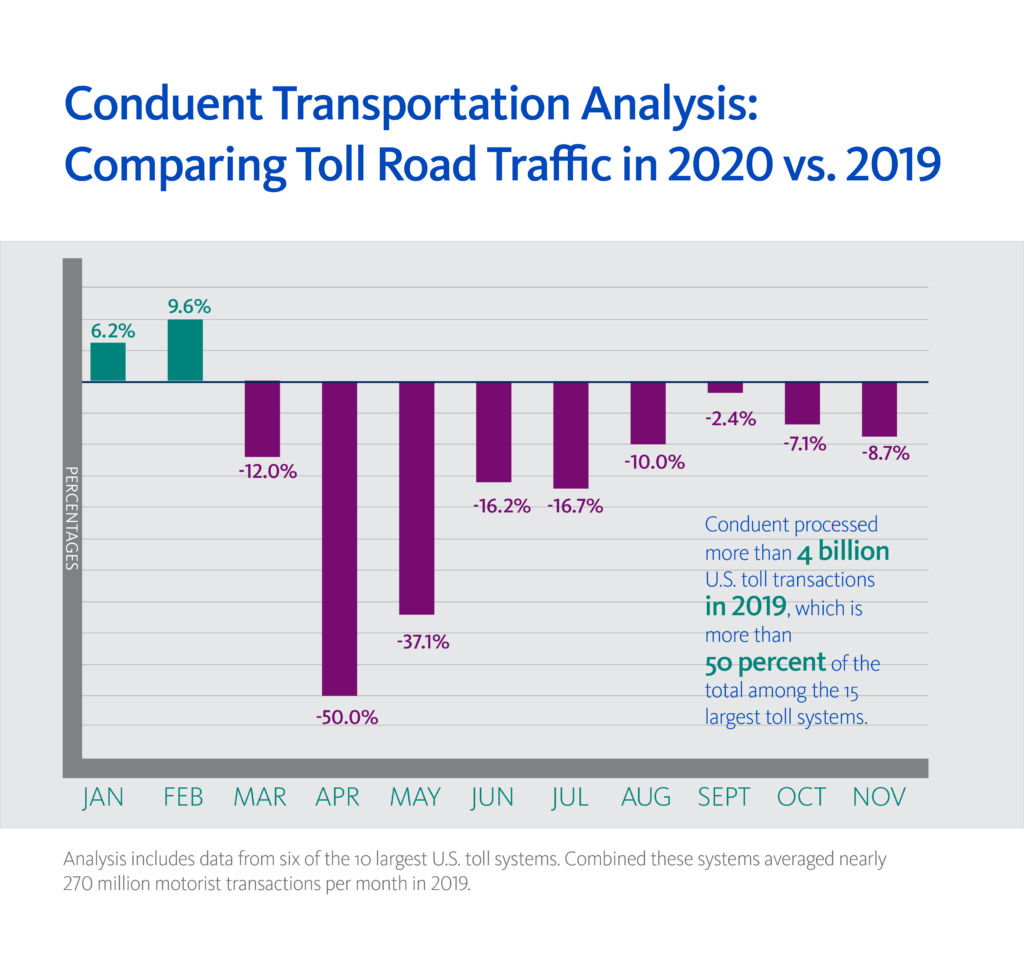Traffic on Major U.S. Toll Road Systems Achieves Strong Recovery Toward Pre-COVID-19 Levels
Traffic volume data closely follows pandemic trends and reopening of communities, as well as proactive steps by toll systems
After the COVID-19 pandemic caused toll road traffic volumes to drop by approximately 50 percent year over year in April 2020, traffic volumes on several of the nation’s largest toll road systems have recovered to an 8.7 percent year-over-year decline in November, according to an analysis of data usage from Conduent Transportation, a unit of Conduent Incorporated (Nasdaq: CNDT). These volumes include electronic toll transactions using a transponder and license plate images captured for toll-by-mail programs.
The gains in traffic volumes are a reflection of states lifting COVID-19-related restrictions since spring, as well as efforts by state and local tolling agencies to encourage road usage by motorists, according to Conduent, the industry leader in automated or electronic tolling across the United States. The company is also supporting clients as more transportation agencies shift to all-cashless transactions, which eliminates the handling of currency and limits exposures.
Traffic trends could remain volatile heading into 2021. For example, the traffic volume recovery peaked in September, but year-over-year declines widened slightly in October and November.
Conduent manages road usage charging, parking, public transit and traffic safety systems for government clients globally. In 2019, Conduent managed more than 4 billion U.S. toll road transactions for transportation agencies, representing more than 50 percent of total motorist transactions among the 15 largest toll road systems in the nation by traffic volume. Conduent’s analysis of 2020 toll road trends encompasses six of the 10 largest toll systems in the U.S., including systems in California, Florida, New Jersey and New York. Combined these systems averaged nearly 270 million motorist transactions per month in 2019.
According to the analysis of 2020 toll traffic versus 2019 levels:
- After year-over-year gains of 6.2 percent and 9.6 percent, respectively, in January and February, traffic volumes declined in March to 12 percent below 2019 levels.
- This year-over-year traffic decline continued dramatically to low points of approximately 50 percent in April and 37.1 percent in May below 2019.
- Since April, traffic improved significantly, flattening to declines of 16.2 percent in June and 16.7 percent in July versus 2019.
- The year-over-year declines narrowed to 10 percent in August and 2.4 percent in September, and declined 7.1 percent in October.
“The recovery in toll traffic on U.S. road systems from the steep declines in the spring shows the impact of states lifting restrictions that kept people off roads and highways and away from local businesses and workplaces,” said Scott Doering, Vice President and General Manager, Road Usage Charging at Conduent Transportation. “The volume improvement is also a result of actions taken by tolling agencies to encourage motorists to get back on the road. While traffic could remain volatile due to broader pandemic trends, the recovery so far has been positive for states that often rely on toll revenue to fund transportation infrastructure improvements.”
According to Doering, proactive steps states have taken to increase road usage included temporary moratoriums on toll charges, suspension of administrative and/or late fees, and the overall shift to cashless transactions.
Category: Driver Stuff, Featured, Fleet Tracking, General Update, Management, News, Safety, Transit News












